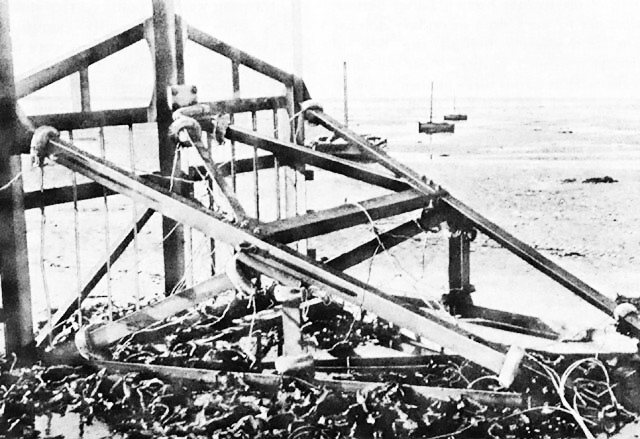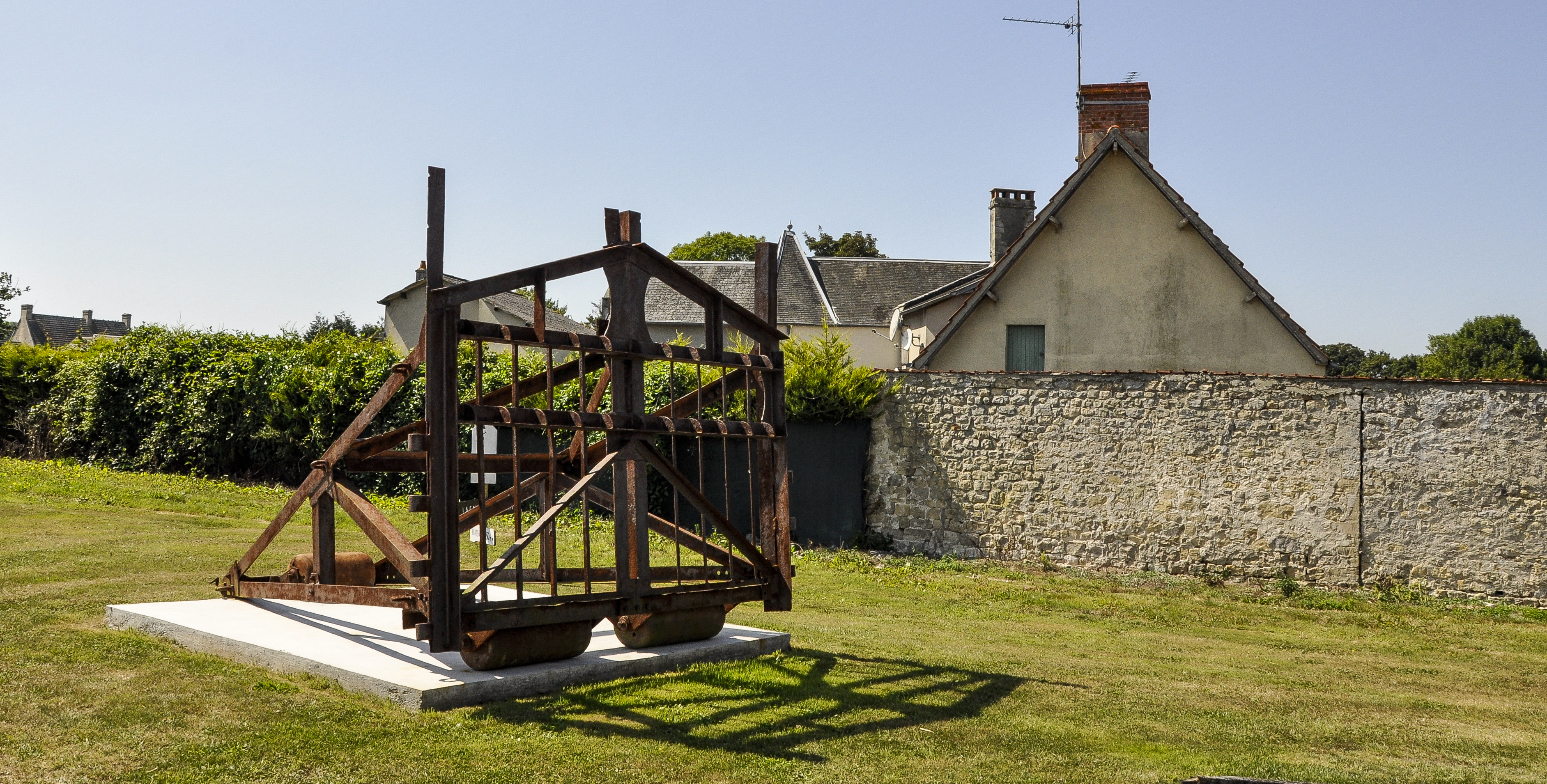Cointet-element on:
[Wikipedia]
[Google]
[Amazon]

 The Cointet-element, also known as a Belgian Gate or C-element, was a heavy steel fence about wide and high, typically mounted on concrete rollers, used as a mobile anti-tank obstacle during
The Cointet-element, also known as a Belgian Gate or C-element, was a heavy steel fence about wide and high, typically mounted on concrete rollers, used as a mobile anti-tank obstacle during
Obstacles on the Normandy battlefieldskwlinie.be – A Belgian inventarisation project of the KW line set up in 2009
Fortification (obstacles) Anti-tank obstacles Military history of Belgium during World War II Maginot Line Military equipment introduced in the 1930s {{Fortifications Fortification (architectural elements) Area denial weapons

 The Cointet-element, also known as a Belgian Gate or C-element, was a heavy steel fence about wide and high, typically mounted on concrete rollers, used as a mobile anti-tank obstacle during
The Cointet-element, also known as a Belgian Gate or C-element, was a heavy steel fence about wide and high, typically mounted on concrete rollers, used as a mobile anti-tank obstacle during World War II
World War II or the Second World War (1 September 1939 – 2 September 1945) was a World war, global conflict between two coalitions: the Allies of World War II, Allies and the Axis powers. World War II by country, Nearly all of the wo ...
. Each individual fence element weighed about and was movable (e.g. with two horses) through the use of two fixed and one rotating roller. Its invention is attributed to a French colonel (later general), Léon-Edmond de Cointet de Fillain who came up with the idea in 1933 to be used in the Maginot Line
The Maginot Line (; ), named after the Minister of War (France), French Minister of War André Maginot, is a line of concrete fortifications, obstacles and weapon installations built by French Third Republic, France in the 1930s to deter invas ...
. Besides their use as barricades to the entrances of forts, bridges and roads, the heavy fences were used in the Belgian "Iron Wall" of the Koningshooikt–Wavre Line (also known as "Dyle Line") and were re-used as beach obstacles on the ''Atlantic Wall
The Atlantic Wall () was an extensive system of coastal defence and fortification, coastal defences and fortifications built by Nazi Germany between 1942 and 1944 along the coast of continental Europe and Scandinavia as a defense (military), d ...
'' defending Normandy from Allied invasion.
History
The Cointet-element formed the main barricade of the BelgianK-W Line
The Koningshooikt–Wavre Line, abbreviated to KW Line (; ) and often known as the Dyle Line after the Dijle (Dyle) river, was a -long fortified line of defence prepared by the Belgian Army between Koningshooikt ( Province of Antwerp) and Wav ...
, a tank barricade that was built between September 1939 and May 1940. Following tests, the Belgian Army
The Land Component (, ), historically and commonly still referred to as the Belgian Army (, ), is the Land warfare, land branch of the Belgian Armed Forces. The King of the Belgians is the commander in chief. The current chief of staff of the Land ...
accepted the Cointet-elements in 1936 after slightly altering the design by the addition of eight vertical beams in the front frame to stop infantry
Infantry, or infantryman are a type of soldier who specialize in ground combat, typically fighting dismounted. Historically the term was used to describe foot soldiers, i.e. those who march and fight on foot. In modern usage, the term broadl ...
moving through them. On 13 February 1939 and 24 July 1939 the first tenders were called for ten groups of five hundred Cointets each. A total of 77,000 pieces were ordered by the Belgian Ministry of Defence and produced by twenty-eight Belgian companies with 73,600 pieces delivered.
Thousands of Cointets were installed on the K-W Line between the village of Koningshooikt
Koningshooikt is a village that since 1977 forms a municipality with Lier in the Belgian province of Antwerp. In the local dialect Koningshooikt is often called ''Jut'' or ''Koningsjut''. Koningshooikt was founded on 1 January 1822, when the vi ...
and the city of Wavre
Wavre (; ; ) is a City status in Belgium, city and Municipalities in Belgium, municipality of Wallonia, and the capital of the Provinces of Belgium, province of Walloon Brabant, Belgium.
Wavre is in the Dijle, Dyle valley. Most inhabitants sp ...
to act as the main line of defence against a possible German armoured invasion through the heartland of Belgium, forming a long iron wall. The Cointet-elements were placed next to each other in a zig-zag and connected with steel cables. Near main roads they were fixed to heavy concrete pillars set into the ground to allow local traffic passage. By May 1940 however, due to a relocation programme, the elements did not form a continuous line and thus were easily bypassed by the 3rd and 4th Panzer Division
The 4th Panzer Division () was an armored division in the Army of Nazi Germany.
In World War II, it participated in the 1939 invasion of Poland, the 1940 invasion of France, and the 1941 invasion of the Soviet Union. It remained on the ...
s.
The Cointet elements were also used as an anti-tank line in a side branch of the K-W Line, which was meant to defend the southern approaches to Brussels
Brussels, officially the Brussels-Capital Region, (All text and all but one graphic show the English name as Brussels-Capital Region.) is a Communities, regions and language areas of Belgium#Regions, region of Belgium comprising #Municipalit ...
. This line branched off the main line in Wavre and ran from there to Halle and on to Ninove
Ninove () is a City status in Belgium, city and Municipalities of Belgium, municipality in the Flanders, Flemish province of East Flanders in Belgium. It is on the river Dender, and is part of the Denderstreek. The municipality comprises the city o ...
, where it ended on the banks of the Dender
The Dender () or Dendre () is a long river in Belgium, the right tributary of the river Scheldt. The confluence of the two rivers is in the Belgian town of Dendermonde.
The Western or Little Dender is long and begins in Barry near Leuze-en-Hain ...
.Tuyteleers, Wim, ''De IJzeren muur bezuiden Brussel. Ninove-Halle-Waver'', 2020, 176 p.
After the German victory in Belgium on 28 May 1940, the Belgian Gates were reallocated across Europe to serve as barricade elements on roads, bridges and beaches. The Germans gave it the name ''C-element''. Large numbers of gates were brought to Normandy during the construction of the '' Atlantikwall'' to be used with the other varieties of beach obstacles. Instead of connecting them, the Germans used them singly next to other items, especially at the low tide line. They were also put on the dikes next to bunkers. Notes from 1944 cite the placement of 23,408 Cointets over of coastline. With many more still present in Belgium after D-Day, the Allies had great difficulty passing them in the last months of the war.
See also
*Cheval de frise
The cheval de frise (, plural chevaux de frise ; , plural , "Frisian horses") was a defensive obstacle, existing in a number of forms, principally as a static anti-cavalry obstacle but also quickly movable to close breaches. The term was also ...
* Czech hedgehog
The Czech hedgehog ( or ') is a static anti-tank obstacle defense made of metal angle beams or I-beams (that is, lengths with an L- or 𝐈-shaped cross section). It is similar in shape to metal knucklebones, although on a much larger scale. Th ...
* Dragon's teeth
References
External links
Obstacles on the Normandy battlefields
Fortification (obstacles) Anti-tank obstacles Military history of Belgium during World War II Maginot Line Military equipment introduced in the 1930s {{Fortifications Fortification (architectural elements) Area denial weapons